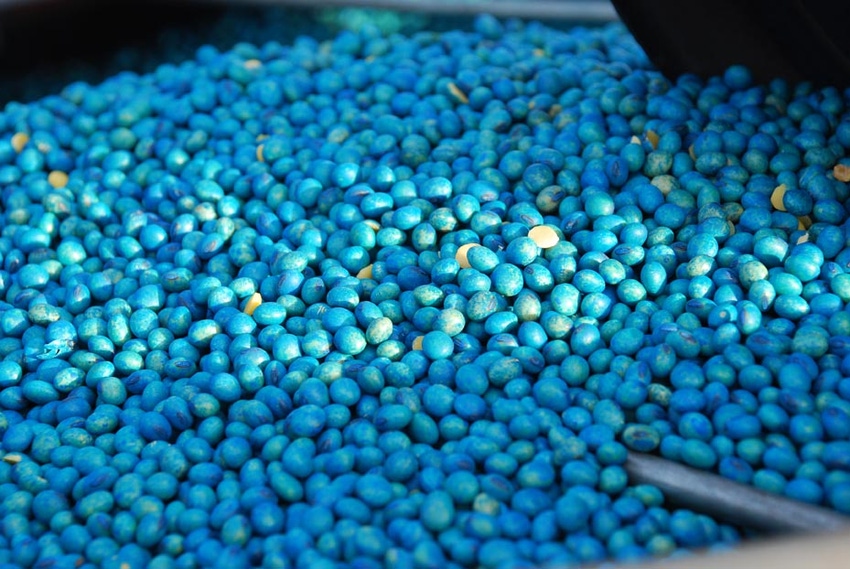April 19, 2013

Fungicide seed treatments protect seedlings from both seed-borne pathogens as well as soil-borne pathogens, says Emmanuel Byamukama, SDSU Extension Plant Pathologist. "Seed-borne pathogens can be those inhabiting the seed surface or those in the interior of the seed. Soil-borne pathogens survive in the soil and when they get in contact with the seed or seedling and the conditions are conducive, the infection process is initiated," he says.
Fungicide seed treatment costs can be high, therefore Byamukama says the decision to treat should hinge on whether the additional yield resulting from the seed fungicide treatment has the potential to offset the cost of seed treatment. He encourages growers to consider the following scenarios when deciding whether or not to purchase a fungicide seed treatment:
1. Is the crop for seed production? Since grain for seed attracts higher prices, it may be beneficial to consider seed treatment in addition to other factors below.
2. What is the history of seedling diseases in your field? For example if a field is known to have high population of the soybean cyst nematode (SCN), then seed treatment with a nematicide may be an option. Preliminary data show that the response to nematicide seed treatment is greater when there is a high population of SCN in the soil.
3. Is the crop following the same crop as last season? Survival of seedling pathogens may be higher in non-rotated fields.
4. Is the crop being planted in tilled or no-till/minimum till field? No-till fields may have an increased risk of seedling diseases.
5. What are the prevailing weather conditions? Wet and cool soils are favorable conditions for most seedling pathogens including Pythium spp. and Phytophthora spp. Cool soil conditions also reduce seedling growth rate, hence providing longer interaction time between the pathogen and the host.
6. Time of planting. Planting early in spring when the soil temperature is likely to fluctuate towards freezing may increase the risk of seed/seedling infection.
7. What is the germination rate for the seed lot? For low germination rates, seed treatment may ensure fair plant stand per acre.
8. How much stand reduction is acceptable? Some crops, like soybeans and wheat, have a great potential for yield compensation. Therefore slightly reduced plant stand is not going to significantly impact yield.
9. What are the desired plant populations per acre? With increasing costs of seed, growers may be opting for lower plant population per acre therefore to avoid further loss of plants; a fungicide seed treatment may be used.
10. Prices. Depending on the prices of grain, higher prices per bushel would indicate that fewer additional bushels are needed to offset seed treatment costs.
11. Replanting because of stand establishment problems especially in wet spots. If replanting is considered, using fungicide treated seeds may increase chances of survival of replanted seed.
Like what you're reading? Subscribe to CSD Extra and get the latest news right to your inbox!
"While it is challenging to predict or measure pre-planting pathogen intensity in the soil and accurately predict the weather conditions – soil temperature and moisture levels – before planting when seed treatments are applied, growers should consider the above enumerated factors to determine if fungicide seed treatment is warranted," Byamukama says.
He says that avoiding unnecessary fungicide treatments not only saves growers unnecessary expenses but also prevents development of fungicide resistance and is benign to the environment.
Increased Yields Not Guaranteed
Research conducted at SDSU on fungicide seed treatments in corn, spring wheat, winter wheat and soybeans over the last six years indicates inconsistent yield increase as a result of fungicide seed treatments.
"For example 52% of soybean fungicide seed treatment trials had a yield difference between fungicide treated and non-treated seed of less than 3 bu./acre," Byamukama says.
Similarly, he says other research results from various studies in the Midwest indicated that the probability of breaking even depended on the environment and genetics of the cultivar used.
"If the environment favored high disease pressure – wet and cool soil temperature – and the cultivar planted was susceptible, then seed treatment was beneficial" Byamukama says. "That's why it is important for growers to scout their fields and have an idea about the history of plant diseases in their fields."
Products to Consider
If seed treatment is discerned to be the best way to go based on the above factors, there are a number of products registered for seed treatment for various crops.
Byamukama says fungicide products that contain the active ingredients metalaxyl or mefenoxam are effective against Oomycetes e.g. Pythium and Phytophthora spp., while active ingredients like captan, carboxin, thiram, fludioxonil and PCNB are effective against Rhizoctonia, Fusarium and Phomopsis.
"Fungicide seed treatment will not compensate for bad seed, for example shriveled, mechanical damaged or impure seed. It should be noted also that fungicide seed treatments are effective for up to three weeks," Byamukama says. "Therefore, slowed seedling growth due to cool soil temperatures or favorable weather conditions for infection three weeks after planting may still pose a risk for potential seedling infections."
When treating the seed and generally when working with pesticides, care should be taken before, during and after seed treatment.
"Questions that growers may have about how to handle left-over seed, treated seed spills, protecting birds and other wild life from treated seeds should be addressed," Byamukama says.
He points growers to a guide published by the American Seed Trade Association (ASTA) and CropLife America (CLA): "The Guide to Seed Treatment Stewardship," available online for free. To learn more, visit iGrow.org.
You might also like:
You May Also Like




